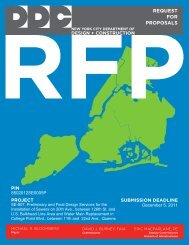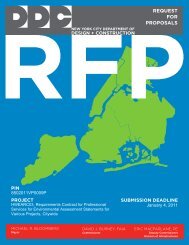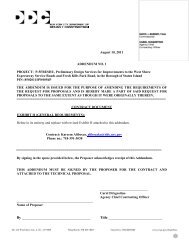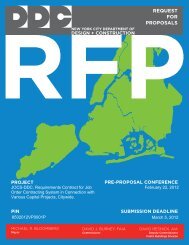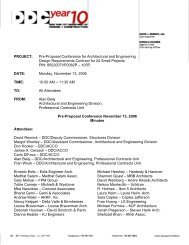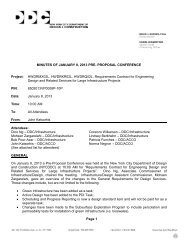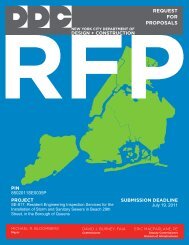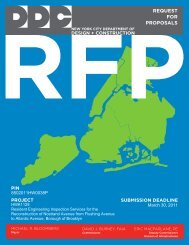requirements contracts for engineering design and related services ...
requirements contracts for engineering design and related services ...
requirements contracts for engineering design and related services ...
Create successful ePaper yourself
Turn your PDF publications into a flip-book with our unique Google optimized e-Paper software.
e) Indicate all existing lane delineations <strong>and</strong> dimensions. Review <strong>and</strong> identify any inconsistencies in the official<br />
marking drawings <strong>and</strong> the field conditions within the project limits, including all terminal intersections. A scaled<br />
CAD drawing of the existing conditions must be submitted that should include existing lane<br />
configuration/assignments, curb regulations, bus stop locations, turn prohibitions, driveways, fire hydrants,<br />
sidewalk widths, street furniture, crosswalk widths <strong>and</strong> type (school, regular <strong>and</strong> hi-visibility), type of traffic<br />
controls (i.e., signal, stop, etc.) <strong>and</strong> any other features that would impact traffic flow, <strong>and</strong> affect curb use as well<br />
as <strong>design</strong> considerations.<br />
f) Conduct a field observation to identify instances of double or illegal parking, queue length <strong>and</strong> number of<br />
queued vehicles (if possible), <strong>and</strong> any other observations that are relevant to reflect existing condition LOS.<br />
g) Identify the additional research <strong>and</strong> analysis of accident data that is needed to provide <strong>for</strong> the proper<br />
completion of the other Tasks included in the specific <strong>requirements</strong> of this contract.<br />
The Traffic Study Program should include a graphic presentation of all intersections to be included in the traffic study as<br />
well as the CAD file as described above.<br />
2. The Consultant shall submit the proposed Traffic Study Program to the Commissioner <strong>for</strong> review <strong>and</strong> approval.<br />
3. The Consultant shall submit <strong>for</strong> approval, the names <strong>and</strong> experience portfolios of all persons <strong>and</strong> subcontractors<br />
proposed <strong>for</strong> use in connection with the Traffic Study Program including traffic counts prior to start of work.<br />
4. Upon approval of the proposed Traffic Study Program, by the Commissioner, the Consultant shall per<strong>for</strong>m the<br />
required ATR <strong>and</strong> TMC, vehicle classification counts, pedestrian/bicycle counts, etc. to identify peak hours <strong>for</strong> traffic, transit<br />
<strong>and</strong> pedestrian analyses; determine traffic volumes to be used <strong>for</strong> levels of service analyses, signal warrant studies,<br />
pavement <strong>design</strong>(s), etc.; <strong>and</strong> to estimate the percentage of truck volumes <strong>and</strong> number of axles as necessary. Vehicle<br />
classification counts shall identify heavy vehicles including trucks <strong>and</strong> buses by number of axles.<br />
5. The Consultant shall research the crash records of the New York City Police Department <strong>and</strong> the New York State<br />
Department of Transportation to obtain the latest available (three-year period) crash data (<strong>for</strong> vehicular, pedestrian <strong>and</strong><br />
bicycle accidents) at intersections <strong>and</strong> mid-block locations within the project limits (including all terminal intersections <strong>and</strong><br />
contiguous to the project limits, where needed). The Consultant shall identify high-crash locations <strong>and</strong> make<br />
recommendations to improve pedestrian, bicycle <strong>and</strong> vehicular safety. A high crash location is one where there were 48 or<br />
more total crashes (reportable <strong>and</strong> non-reportable) or five or more pedestrian/bicycles injury crashes in any consecutive 12<br />
months of the most recent 3-year period <strong>for</strong> which data is available.<br />
6. The Consultant shall visit the site <strong>and</strong> become familiarized with the site conditions, analyze the latest available<br />
three-year accident data to determine accident patterns <strong>and</strong> probable contributing factors, <strong>and</strong> shall identify all<br />
subst<strong>and</strong>ard conditions contributing to the accidents, <strong>and</strong> propose appropriate mitigation measures.<br />
7. The Consultant shall contact the respective NYCDOT’s Borough Commissioner’s Office <strong>for</strong> records of all<br />
outst<strong>and</strong>ing traffic-<strong>related</strong> (i.e., pedestrian, bicycle, <strong>and</strong> vehicular) operational <strong>and</strong> safety complaints submitted by the<br />
Community Board(s) having jurisdiction over the project area, <strong>for</strong> consideration <strong>and</strong> improvements.<br />
8. The Consultant shall contact the Department of City Planning (DCP) <strong>and</strong> NYC Economic Development<br />
Corporation (EDC) <strong>for</strong> in<strong>for</strong>mation about any planned <strong>and</strong>/or approved future developments/actions (to occur within the<br />
project’s <strong>design</strong> year) located within or at the close proximity of the project limits that can have potential impact on traffic<br />
throughout the project area.<br />
9. The Consultant shall consider the traffic generators, l<strong>and</strong> use, zoning, bus <strong>and</strong> bicycle routes, etc. that can impact<br />
the present <strong>and</strong> future traffic operations, <strong>and</strong> incorporate in<strong>for</strong>mation with appropriate maps in the report.<br />
10. In accordance with the NYCDOT procedures, the Consultant shall prepare signal warrant studies <strong>for</strong> unsignalized<br />
intersections that exhibit operational <strong>and</strong> safety problems in accordance with the approved Traffic Study Program. The<br />
Consultant shall prepare a left-turn signal warrant study if a left-turn phase is proposed. The signal warrant <strong>for</strong>ms may be<br />
obtained from NYCDOT’s Signals Division. The completed <strong>for</strong>ms shall be submitted to Signals Division <strong>for</strong> review <strong>and</strong><br />
approval.<br />
NYC Department of Design <strong>and</strong> Construction<br />
Infrastructure, October 2012<br />
GR-24




